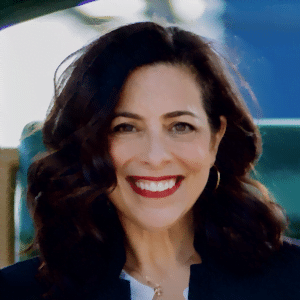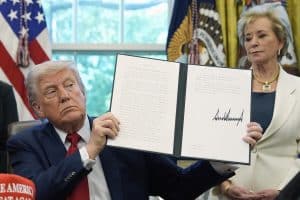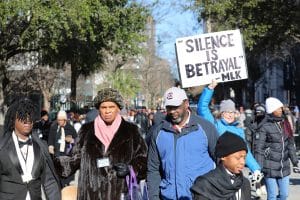More and more people are finally becoming aware of the dangers of Project 2025, a presidential transition plan for Donald Trump (should he win in November) that would gut our constitution and upend our democracy. One institution in its crosshairs is public education – which it effectively wants to end.
One way people need to approach this document is to think about how this will affect them locally – like in Central Bucks School District – which might cease to exist in the next 10 years if Trump wins and Project 2025 is carried out.
This far-right, Christian nationalist policy agenda is made up of 30 chapters. Chapter 11 is a 44-page outline of plans for Education written by Lindsey M. Burke. There are myriad issues that this chapter covers. In this article, I am going to address two of them – school choice and title IV – school discipline and disparate impact.
First, for some context, the author of this chapter makes no secret of her underlying goal to dismantle public schooling. She has recently reposted articles calling for the abolition of public schools on the social media platform X. Also, although Burke is a legitimate scholar, the chapter is written with inflammatory rhetoric and information with no citations or factual grounding, For instance, she refers to her detractors as “woke ‘diversicrats’” and federal accrediting bodies as a “cartel.” Later in the chapter she makes statements regarding what academic studies and teachers say, but offers no evidence to support the claims.
There are many issues to be covered related to the plan for education in Project 2025. However, I will only cover a few for this column.
School Choice
First, the issue of school choice. School choice is a big one. And, I completely understand why the idea of school choice sounds compelling to many people. Many years ago when I first heard about the idea of vouchers, my initial reaction was positive. What could be bad about giving parents a choice about where to send their children to school? However, the problem is both in the practical application and the rationale behind it.
School choice has been front and center in discussions at the state level for a while now. Senate majority leader, Joe Pittman is quotes as saying that, “Every child should have access to educational opportunities” and he believes that parents should be empowered to decide the best option for their child’s education”. However, this is pure propaganda. The entire premise of school choice is based on a very surface level understanding of the practical implications.
The school choice movement is built on the assumption that the free market will create an amazing menu of schools from which parents and children can choose. The idea is that kids will leave failing schools and if those schools don’t want to lose the funding that comes with the students via vouchers, they will get better. Think about that logic – students leave, funding leaves, and then somehow the school improves with fewer resources.
READ: Pennsylvania Taxpayers Are Subsidizing Discrimination at Private and Religious Voucher Schools
CBSD serves approximately 17,540 students with a per pupil expenditure of $16,933 per student. If 15% of CBSD families decided to use a voucher and send their children to private school that would represent about 2,631 students. I don’t know how much a voucher would be, but estimates are in seven thousand dollar range. Note the difference in how much we currently spend per student and the amount of the voucher. This is partly why some lawmakers love this plan. It will save the state and federal government a lot of money and put the onus on parents.
If 15% of students leave CBSD, they will take approximately $18,471,000 with them to other schools. It is true that CBSD will have fewer students to serve. But, it will absolutely mean teachers and other staff losing their jobs as well as the elimination of programs, perhaps sports teams, maybe even electives and AP courses.
Also, this proposal includes eliminating almost all federal oversight and instead sending money in the form of block grants to states. Eliminating Title 1 funding and funding associated with the Individuals with Disabilities Education Act [IDEA] are both on the chopping block. Both of those federal funding sources are meant to support our most vulnerable children. It is likely that student/teacher ratios related to serving children with special needs will be an easy target for a place to cut teachers and support staff. We will have to hope that every state uses those monies wisely and equitably. For parents of children who are struggling or who have special needs, this is terrifying.
Additionally, what we have seen in similar districts that have had to deal with budget cuts is bigger class sizes, students having to pay to play sports and participate in certain clubs, and the elimination of lab sciences. For instance, a district in New Jersey with similar demographics to CBSD eliminated labs for all sciences unless they are AP courses. This allowed them to add one class to each science teachers’ schedule. So, teachers can teach more [non-lab] courses but only the most high-achieving students who choose to take an AP course get the benefit of the hands-on and authentic learning that happens in a lab.
The fact is that this is really a proposal to dismantle public schooling altogether. To be sure, there are improvements that can be made to the way we do public schooling, particularly funding. However, decades of charter schools have shown us that many people think they know how to create a great school, and they fail miserably. Charter schools were originally intended to be sort of lab schools. They would be a place to try out innovative pedagogical approaches and then bring them to the public schools. Instead, many charter schools have been opened by people who seem to believe they know more about education than they do. A common problem actually. I have often thought that because we have all experienced twelve years of schooling, there is a feeling that we know how to do it. Unfortunately, the evidence suggests something very different. Charter schools have very high closure rates. In fact, more than a quarter of all charter schools close within 5 years and half close within 15 years. Over the past 30 years, almost a million students have been displaced, often from low income and minority communities, due to charter school closures. Failure rates after ten years are documented as high as 55% in Wisconsin, 48% in Arizona, 42% in Florida, and 41% in Michigan. Imagine putting your child in a charter school, full of hope for a great education, only to find yourself looking for a new school in a few years because the school is failing and maybe shut down completely. Now your child has not only experienced a cumulative loss of content but they will surely arrive at their next school underprepared. Even among fully functioning charter schools, graduation rates are often less than 50%. Project 2025 is proposing even less regulation on charter schools than currently exists. It is not too difficult to surmise that this proposal will lead to many students getting subpar education.
Now, let’s deal with the rationale for school choice. To make their argument, Burke uses a lot of contradictory logic. For example, she writes that there is hostility toward “free expression, open academic inquiry, and American exceptionalism”. However, the entire approach to education is premised on silencing the free expression of anyone who disagrees with the conservative views promoted throughout the document. In fact, it is hard to understand how one squares promoting American exceptionalism in the same sentence as open academic inquiry since American exceptionalism resists the need to teach a full and true history of our country so that we may learn from our mistakes.
There is also an argument that schools need to better prepare students for a diverse workforce and a pluralistic society. Again, on its face, that seems reasonable. As Katharine Kayhoe writes, “propaganda works best by wrapping it in something true” (in this case, the importance of preparing students for a diverse workforce). But, their proposed way to do that is contradictory to the goal. For instance, there is language about promoting “traditional American values” and “safeguarding civil rights”. But “traditional American values” are not defined, it is not too difficult to understand that the intent is to turn back to a time when students were expected to assimilate into a specific version of American culture. In the early 20th Century public schooling became compulsory for a specific reason — to dissolve parochial and private schools due to a fear of immigrants, particularly Catholics. Now, ironically, conservatives are making an argument to send taxpayer money to parochial and private schools, but for the same end – to indoctrinate everyone into one way of thinking.
READ: Christian Nationalists Are Closer than Ever to Getting Church-Run Public Schools
As for civil rights, this proposal calls for safeguarding the rights each person has by rejecting “gender ideology”. Their position on gender ideology is being gay, specifically trans, is an ideological stance rather than an intrinsic identity. Because they basically believe people are making it up or are mentally ill, they want to prohibit schools from supporting students who identify as gay or trans. It is unclear to me how rejecting the identity of certain students is compatible with protecting their rights no matter their race, sex, or religion.
Further, Burke has decided to throw critical race theory [CRT] back in the mix of ideas we should reject. No doubt this is because Christopher Rufo’s demonization and weaponization of CRT was so successful a few years ago. But here is the deal – critical race theory is not being taught in K-12 settings. And, even if it was, all it really calls for is considering a situation through the lens of race. For instance, looking at a scenario with race in mind. An example might be school segregation prior to the Brown v. BoE case. I could see a class discussion where high school students might consider the impact of school segregation from the perspectives of White teachers and students versus Black teachers and students. I suppose that could be read as CRT, but it is also a great example of open academic inquiry – something Burke argues for.
Finally, here is a very practical matter, transportation and actual tuition. School choice is not just a matter of going anywhere you want, it’s also getting there and paying for it.
Proponents of this movement want government out and parents in – in every aspect of the process. Parents should be prepared to provide transportation and if you can’t— too bad, your child will be stuck in the local school that has been depleted of funds because the parents with more financial means will have taken their children with their tax dollars to schools they can access because their finances or schedules allow. This will result in just another way to amplify socioeconomic disparities. Those disparities will also be evident because each school will carry a different price tag. Will your tax bill cover the school you want? What if you always wanted to send your child to a sweet private school with a big price tag? Parents are kidding themselves if they think the voucher is going to be enough to cover any school they choose. Take a look at your school tax bill. Again, parents who can kick in the difference will benefit. Those of us who don’t have those funds will be left making very difficult decisions about leaving our children in schools depleted of resources.
Title IV: School Discipline and Disparate Impact
Burke writes, “Assuring a safe and orderly school environment should be a primary consideration for school leaders and district administrators.” Who would argue with that? I agree. However, in the next few sentences it is easy to see where this is going. Burke lays out contention with former president Obama’s stance that schools could lose federal funding if it was found that they treated students of color differently with respect to discipline for the same offenses. Further, she takes issue with the requirement to institute restorative justice and falsely claims that “academic studies, as well as student and teacher surveys, suggest that academic and school climate have been harmed substantially by this push”. This could not be further from the truth. Restorative justice is a relationship centered approach for “avoiding and addressing harm, responding to legal and human rights, and collaboratively solving problems”. In a comprehensive report looking at 18 different research papers published between 2002 and 2018 it was found that a restorative justice approach improves social emotional growth and positive development of students, improves school climate, and fosters healthy resilient students who are ready for college and career. The studies also show a large and statistically significant positive impact on teachers’ views about school safety. And, statistically significant improvements in teachers’ perceptions about working conditions being conducive to teaching and learning were reported. So the takeaway here is that in order to justify trampling students’ civil rights they grossly misrepresented the efficacy of a positive approach to discipline and school climate. This is no surprise since operatives like Christopher Rufo proudly say things like, “To get universal school choice, you really need to operate from a premise of universal public school distrust” and he counsels his supporters to be “ruthless and brutal” in their approach.
As we enter this election cycle, I believe the call for everyone is to consider the purpose of public schooling.
A child’s education benefits everyone. One of our founders, Thomas Jefferson, believed that our survival as a free people was dependent on having an educated citizenry. While our current public school system is not perfect, it has a positive influence both on individual students and the community. Public education provides access for children to learn the skills they need for life and work. But more than that, it has wide reaching social and economic benefits to individuals, families and communities.
A well educated community has less unemployment and reduced dependence on public assistance. In addition education is shown to be related to “reduction in crime, improved public health, and greater political engagement.” The benefits of ensuring that every child has access to quality education is clear. There is room for improvement. There are certainly schools that are not living up to the promise for their students. However, the movement toward school choice and deregulation is very likely to leave even more children behind and widen gaps in achievement, education and career attainment, and socio-economic well being.







